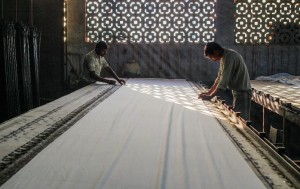
Dyeing is one of the main processes that is responsible for the beautification of textiles; giving them colour, vibrancy and lustre. The global awareness for the need to eliminate chemical dyes harmful to the environment and the end user has led to the emergence of herbal dyes. These dyes are herbal extractions and have excellent qualities when compared with the harmful chemical dyes.
Herbal extracts manufacturers take all care to ensure that their products are of highest standards in order to maintain their renowned quality. A fabric that is dyed with extracts form varied herbs is called as an herbal textile. Herbal dyes differ from vegetable dyes as the dyeing process with the latter requires the use of catalysts like ferrous sulphate and copper sulphate. Whereas in the case of herbal dyes there are no chemicals used in any form whatsoever; in fact their medicinal value is transferred on to the fabric they are dyed on. Some of the herbal extracts that go into textile dyeing come from Manjistha, Neem, Sandalwood, turmeric and so on.
A few of the advantages gained by use of dyes obtained from herbal extracts are their biodegradability, eco-friendliness and goodness for health of the end user. This is the reason that more and more of the global customers are opting for herbal textiles. Herbal textiles help to reduce allergy issues and give a high degree of comfort to the wearer of the fabric. Low carbon footprint is emitted from this form of textile and since it is eco-friendly the requirement of water, energy and the toxic runoff is highly reduced. Strict quality controls ensure that contaminants such as lead, amines, nickel and formaldehyde are totally absent from the textiles.
Yarn and fabric that can undergo herbal dyeing include natural cotton, wool, jute, linen, hemp and organic cotton. Every step of the herbal textile production process is controlled and the dyeing aspect is characterized by the absence of chemical process. The manufacturing processes are somewhat similar to the ones used in regular textile manufacturing but the materials used for each process differs.
Herbal textiles have several applications like they are used in manufacture of bed covers, towels, under garments, meditation clothes, night gowns or pyjamas and any other apparel that comes in close contact with the skin. Other items like door mats, mattress, coir mats and carpets also have adopted the same technology followed for producing herbal apparel.
Herbal extracts are being used for their medicinal value since ancient times but today, their use in the making of herbal textiles is gaining momentum. Herbal extracts manufacturers are viewing this additional market for their products most positively.
However, the world of colours is not limited to herbal dyes alone; there are several other pigments and dyes too which have found their way in many more applications. There are pigments for paint, plastics, inks, food and beverages etc in varied colours like acid black, acid red, acid yellow and so on. However, not all follow the green technology that is so much needed in today’s times.